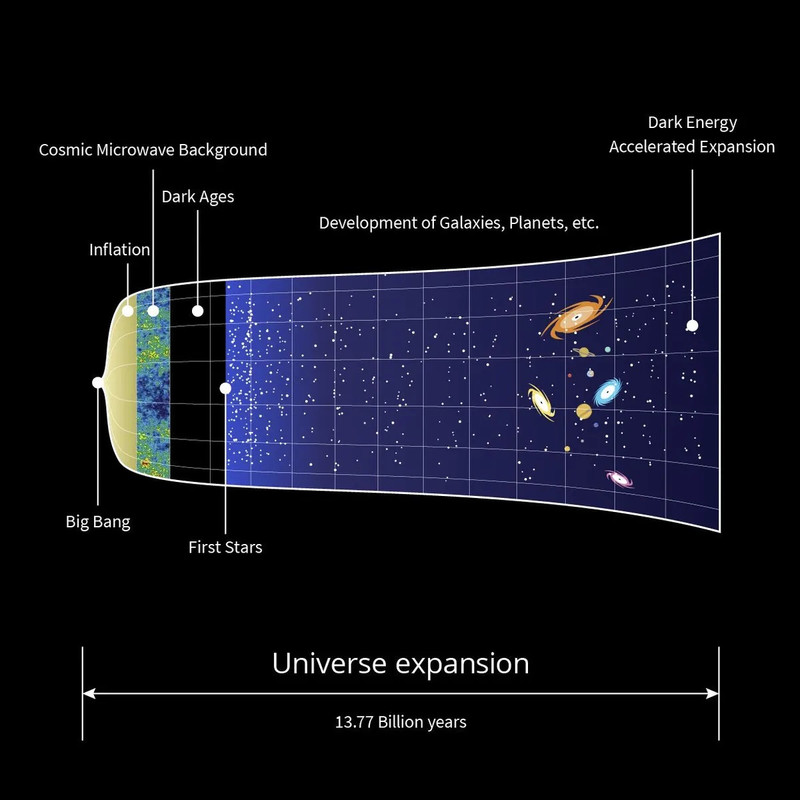
I need to add the credits (later)
If you study the diagram, each vertical line represents an instant in the evolution of the Universe. Each line then represents the universe's 3-dimensional space, and in perspective would be a circle. The horizontal distance (13.77 billion years), and we can adjust the diagram by compressing the illustration until all vertical lines are just concentric circles, all of which represent nested spheres. In this modified diagram, the time distance is compressed to the diameter of the sphere. Using this diameter, we know that the circumference is confirmed by the Hubble Constant.
Nothing controversial so far (just presented differently).
- Compression of Time Dimension: By conceptually "squeezing" the time axis—flattening it into a radial parameter—you transform the diagram from a temporal sequence into a spatial embedding.
- Concentric Circles as Spherical Expansion: Each circle now represents a spatial slice of the universe at a given moment, with time encoded as radial depth. The outermost circle is the present; the innermost, the Big Bang.
- Time Becomes Radius: This is the key shift. Instead of time flowing horizontally or vertically, it becomes a geometric radius—a scalar measure of embedding depth in a higher-dimensional manifold.
- Each nested shell is a moment in cosmic history.
- The radius from the centre to any shell is not just spatial—it’s temporal.
- Observing outward is observing forward in time; looking inward is peering into the past.
Think of Time as Dark Energy expanding the hypersphere universe. A process. A radial force. (What and how it may work can be considered if there is any interest here.) The model is then a 4D hypersphere in a 5D embedding space with time denoted by its radius.
The Hyperspherical Presumption: Curvature as Default, Not Exception
“If we accept that the universe emerged from a 4D event into a 5D embedding space, then the most natural geometric expectation is a hypersphere—a spherically symmetric 4D manifold embedded in higher-dimensional space. This isn’t speculative flourish; it’s the default geometry of expansion in higher-dimensional physics.
In this view, time is not a spatial axis but a scalar radial parameter—marking depth of embedding rather than direction of travel. The concentric structure of cosmic evolution becomes a nested hypersphere, with each layer representing a deeper temporal slice.
Therefore, the burden of proof shifts: it is not the curved model that must justify itself, but the flat model that must explain why a spherically expanding hypersurface would somehow flatten out without cause.
Attempts to treat time as a fourth spatial dimension—folded into Minkowski spacetime—may serve mathematical convenience, but they lack ontological credibility when applied to cosmological embedding. These contortions obscure the intuitive geometry of expansion and misdirect interpretation of observational data.”
- Curvature as Default: flipping the epistemic burden—flatness becomes the anomaly, not the baseline.
- Radial Time: This scalar treatment of time dissolves the need for spacetime contortions and aligns with visual analogies (nested spheres, Russian dolls).
- Observational Consequences: If curvature is real but unacknowledged, then phenomena like cosmic acceleration, horizon problems, and dark energy may be artifacts of misinterpreted geometry.
Well, so far, not too far out of the box, but consider this thought
2. Radial Time and Hyperspherical Expansion
- Time is not a fourth spatial axis—it’s a scalar radius.
- The universe is a nested hypersphere: each concentric layer represents a deeper temporal slice.
- Visual analogy: Russian dolls or nested spheres, where depth equals age.
3. Observational Consequences
- Rim regions of distant galaxies appear “sunken” due to curvature.
- If you assume flatness, you must explain this via dark energy or expansion.
- But curvature alone can account for these distortions—no exotic energy required.
4. Philosophical Challenge
“Treating time as a spatial dimension leads to conceptual contortions. A radial scalar model preserves intuitive geometry and aligns with higher-dimensional embedding.”5. Call to Reframe
- Invite readers to reconsider standard cosmological diagrams.
- Suggest that curvature is not a speculative add-on—it’s the default geometry of expansion.
Core Idea
- Instead of invoking a mysterious inflaton field to drive exponential expansion, you posit that the early universe is the interior of a supermassive black hole embedded in a higher-dimensional space.
Why This Is Intriguing
- Natural Geometry: A black hole’s interior already has extreme curvature and causal structure—ideal conditions for rapid expansion or “inflation-like” behavior.
- Radial Time Compatibility: Your model of time as radial depth fits beautifully here. The deeper into the black hole’s interior, the earlier the cosmic epoch.
- Avoids Exotic Fields: It sidesteps the need for an inflaton field with fine-tuned parameters, replacing it with a known physical entity: a black hole.
Philosophical and Physical Implications
- Causal Horizons: The black hole’s event horizon could act as the cosmic horizon, naturally explaining the uniformity of the observable universe.
- Embedding Space: The parent BH exists in a 5D or higher-dimensional space, allowing the universe to be a 4D hyperspherical interior.
- Singularity as Genesis: The singularity becomes the Big Bang—not as a point of infinite density, but as a geometric boundary condition.
Hmm maybe a step too far or the BB bit needs more thought